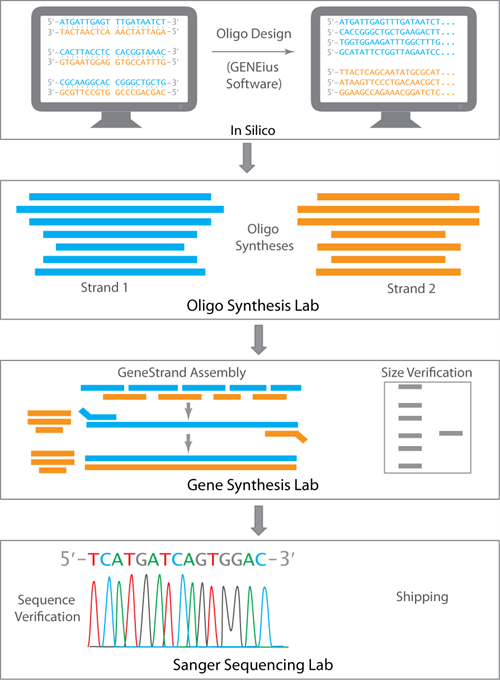Step 1:
 Once the order has been submitted the propreitary GENEius software tool breaks the sequence down to smaller oligos to ensure that there is sufficient overlap between contiguous oligos and the complementary bridging splint.
Once the order has been submitted the propreitary GENEius software tool breaks the sequence down to smaller oligos to ensure that there is sufficient overlap between contiguous oligos and the complementary bridging splint.
Step 2:
The designed oligos are then synthesized at our DNA Synthesis Lab using high-fidelity chemical synthesis - very high coupling efficiency and mild post-synthesis clean up. The mass spec. validated oligos are then used in the assembly of the dsDNA.
Step 3:
The oligos are processed, annealed, and then ligated to contruct one strand of the full length DNA. High-Fidelity DNA polymerases are then used to generate the second strand and amplify the dsDNA. The size of the resulting PCR product is verified by gel electrophoresis using a gel with the appropriate resolution.
Step 4:
The size-verified DNA is then dried down and shipped as GeneStrand to you. The size-verified dsDNA can be sequenced at our sequencing lab for additional confirmation. Sequence validation is of the entire pool, so the results obtained are a representation of the predominant sequence within the pool. Sequence information is kept confidential at our facility. A copy of the sequence will then be available for a $25 fee.
We ensure strict confidentiality of every project. The high quality standard of our service is assured by a professional quality management team. The quality management system of our Louisville, Kentucky facility is certified to ISO 9001:2008 and ISO 13485:2003 quality standards.
Sequence optimization (optional)
Sequences of high complexity may prolong the overall turnaround time of delivery and, in some extreme cases, disqualify the sequence for delivery as GeneStrand. Please note that we offer free in silico sequence optimization option on our website. This optimization can eliminate sequence complexities, while increasing the yield the protein expressed in the host.
Complexities in a sequence
Complex segments in the sequence make synthesis of oligos and the assembly of GeneStrand gene fragments challenging, while also reducing the efficiency of transcription and translation. Complexities in a sequence include:
- Stretches of direct or inverted repeats (>20 bp)
- homopolymeric stretches (>18 bp)
- Stretches of sequence that can result in critical secondary structures
- Stretches of sequence with very high (>75%) or low (<35%) GC content.
Secondary structures reduce the synthetic yields of DNA oligos while also reducing the translational efficiency, since these secondary structures are then adopted by the mRNA. Any Genes or GeneStrands that contain these features are considered 'complex' and take longer to assemble.